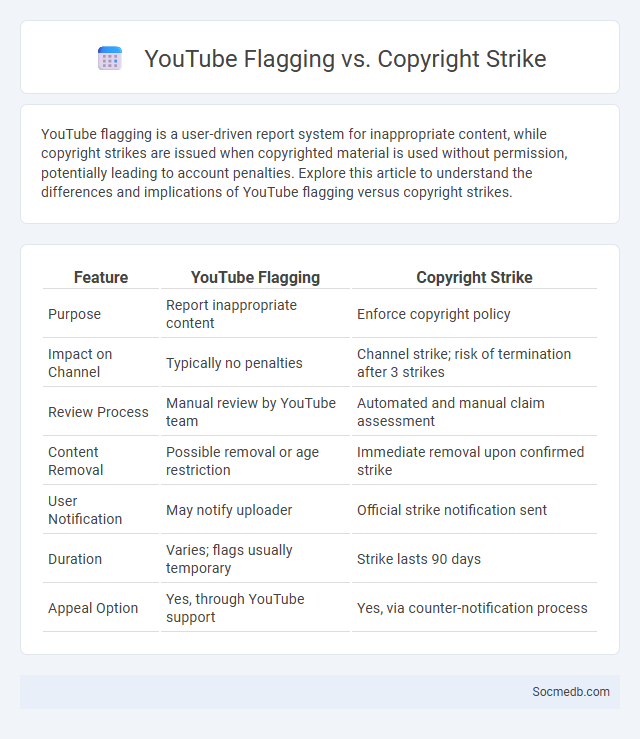
Photo illustration: YouTube Flagging vs Copyright Strike
YouTube flagging is a user-driven report system for inappropriate content, while copyright strikes are issued when copyrighted material is used without permission, potentially leading to account penalties. Explore this article to understand the differences and implications of YouTube flagging versus copyright strikes.
Table of Comparison
| Feature | YouTube Flagging | Copyright Strike |
|---|---|---|
| Purpose | Report inappropriate content | Enforce copyright policy |
| Impact on Channel | Typically no penalties | Channel strike; risk of termination after 3 strikes |
| Review Process | Manual review by YouTube team | Automated and manual claim assessment |
| Content Removal | Possible removal or age restriction | Immediate removal upon confirmed strike |
| User Notification | May notify uploader | Official strike notification sent |
| Duration | Varies; flags usually temporary | Strike lasts 90 days |
| Appeal Option | Yes, through YouTube support | Yes, via counter-notification process |
Understanding YouTube Flagging
YouTube flagging is a crucial tool that helps maintain a safe and respectful platform by allowing users to report inappropriate or harmful content. When you flag a video, YouTube's algorithms and human moderators review the report to determine if the content violates community guidelines such as hate speech, nudity, or misinformation. Understanding how flagging works empowers you to contribute to a healthier online environment and supports content creators who adhere to YouTube's standards.
What Is a Copyright Strike on YouTube?
A copyright strike on YouTube occurs when a video violates the platform's copyright policies by using content owned by someone else without permission. This strike can lead to video removal, loss of monetization privileges, and restrictions on account features, with three strikes potentially resulting in account termination. YouTube uses content identification tools and manual claims to enforce these rules and protect creators' intellectual property.
Key Differences: Flagging vs Copyright Strike
Flagging on social media involves reporting content that may violate community guidelines, often leading to content review or removal if found inappropriate. A copyright strike is a formal complaint alleging unauthorized use of copyrighted material, which can result in restrictions, content takedowns, and penalties for repeat offenders. Unlike flagging, copyright strikes carry legal implications and can affect the user's account standing more severely.
The Flagging Process Explained
The flagging process on social media platforms involves users reporting content that violates community guidelines or terms of service. Once flagged, content undergoes review by automated systems and human moderators to determine if it breaches rules such as hate speech, misinformation, or harassment. Efficient flagging helps maintain platform safety and ensures compliance with legal standards while protecting user experience.
How Copyright Strikes Work on YouTube
YouTube copyright strikes occur when copyrighted content is uploaded without the owner's permission, triggering automated Content ID matches or manual takedown requests. Each strike limits your account features, and accumulating three strikes within 90 days can result in termination of your channel and removal of all your videos. Understanding YouTube's copyright policies helps you protect your content and avoid penalties that impact your account's standing.
Consequences of Flagging vs Copyright Strikes
Flagging on social media often results in temporary content removal or review, serving as a warning mechanism without severe penalties, while copyright strikes impose stricter sanctions including account suspension or permanent bans. Your awareness of the distinction helps avoid unintentional violations and protects your online presence from escalating enforcement actions. Understanding how platforms enforce flagging versus copyright strikes is essential to maintain content compliance and safeguard your digital reputation.
Common Reasons for Flagging Videos
Common reasons for flagging videos on social media include inappropriate content such as hate speech, violence, and nudity, which violate community guidelines and harm user experience. Misleading information or spam content also prompts flags to protect viewers from false claims and maintain platform integrity. Understanding these reasons helps you create compliant videos that avoid unnecessary removal or restriction.
How to Respond to a Flag or Copyright Strike
When you receive a flag or copyright strike on your social media account, immediately review the specific content in question and compare it against copyright laws and platform guidelines. You should file a counter-notification if you believe the strike is mistaken or the content qualifies as fair use, ensuring your response follows the platform's official procedures. Protecting your account's integrity involves timely addressing strikes to avoid penalties or account suspension.
Preventing Flags and Copyright Strikes
To prevent flags and copyright strikes on social media, ensure your content is original or properly licensed, and always credit rightful owners when using third-party materials. Maintaining compliance with platform guidelines and regularly reviewing updates on copyright laws can safeguard your account. Protect your digital presence by using content identification tools and avoiding reposts of copyrighted media without permission.
YouTube’s Policies on Content Reporting and Copyright
YouTube's policies on content reporting strictly enforce copyright laws to protect creators' intellectual property, enabling efficient handling of violations through their Content ID system and copyright takedown procedures. Users can report copyright infringements directly via YouTube's reporting tools, which prioritize accuracy and compliance with the Digital Millennium Copyright Act (DMCA). These policies ensure a balanced approach between protecting original content and allowing fair use under established legal frameworks.
 socmedb.com
socmedb.com